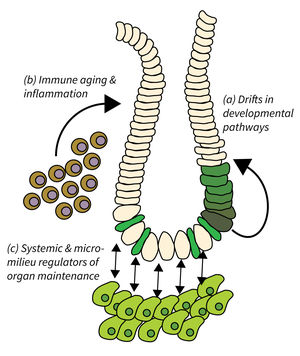Subarea 2: Regeneration and Homeostasis of Organs in Aging
The main goal of Subarea 2 is to identify cellular and molecular pathways used to ensure effective organ maintenance and repair, and to unravel the mechanisms of their deterioration during aging. While stem cells are important for organ homeostasis, this Subarea does not per se directly addresses stem cell aging but rather focusses on the following focus areas:
- Drifts in developmental pathways limiting organ maintenance in aging,
- Immune aging and inflammation, and
- Systemic and micro-milieu regulators of organ maintenance, regeneration, and disease development.
Research focus of Subarea 2
Organ maintenance is regulated by local and systemic factors, which are subject to aging-associated changes. Research of Subarea 2 focuses on the following research areas: a) Genetic and epigenetic modulation of developmental pathways has been shown to contribute to progressive aging and disease. It is critical to delineate mechanisms and consequences of aging-associated drifts to better understand organ maintenance during aging. b) Immunoaging and chronic inflammation elicits negative effects through reduced immune surveillance and aberrant organ repair and maintenance; all of which contributes to the evolution of organ pathologies and diseases during organismal aging. c) Furthermore, aging-associated alterations in systemic and extracellular factors derived from metabolic changes, microbiota alterations, chronic inflammation, senescent, or damaged cells might impinge on disease development and tumor initiation.
Publications
(since 2016)
2020
- SHP1 regulates a STAT6-ITGB3 axis in FLT3ITD-positive AML cells.
Reich D, Kresinsky A, Müller JP, Bauer R, Kallenbach J, Schnoeder TM, Heidel FH, Fässler R, Mann M, Böhmer FD, Jayavelu AK
Leukemia 2020, 34(5), 1444-9 - The stress-responsive gene GDPGP1/mcp-1 regulates neuronal glycogen metabolism and survival.
Schulz A, Sekine Y, Oyeyemi MJ, Abrams AJ, Basavaraju M, Han SM, Groth M, Morrison H, Strittmatter SM, Hammarlund M
J Cell Biol 2020, 219(2), doi: 10.1083/jcb.201807127 - Der Hippo-Signalweg in der Regeneration und im Krebs
Tollot M, Cindric Vranesic A, von Eyss B
BIOspektrum 2020, 26, 154–157
2019
- C/EBPβ-LIP induces cancer-type metabolic reprogramming by regulating the let-7 /LIN28B circuit in mice.
Ackermann T, Hartleben* G, Müller* C, Mastrobuoni G, Groth M, Sterken BA, Zaini MA, Youssef SA, Zuidhof HR, Krauss SR, Kortman G, de Haan G, de Bruin A, Wang ZQ, Platzer M, Kempa S, Calkhoven CF
Commun Biol 2019, 2, 208 * equal contribution - RelB Deficiency in Dendritic Cells Protects from Autoimmune Inflammation Due to Spontaneous Accumulation of Tissue T Regulatory Cells.
Andreas* N, Potthast* M, Geiselhöringer AL, Garg G, de Jong R, Riewaldt J, Russkamp D, Riemann M, Girard JP, Blank S, Kretschmer K, Schmidt-Weber C, Korn T, Weih F, Ohnmacht C
J Immunol 2019, 203(10), 2602-13 * equal contribution - Cohesin-mediated NF-κB signaling limits hematopoietic stem cell self-renewal in aging and inflammation.
Chen Z, Amro EM, Becker F, Hölzer M, Rasa SMM, Njeru SN, Han B, Di Sanzo S, Chen Y, Tang D, Tao S, Haenold R, Groth M, Romanov VS, Kirkpatrick JM, Kraus JM, Kestler HA, Marz M, Ori A, Neri F, Morita** Y, Rudolph** KL
J Exp Med 2019, 216(1), 152-75 ** co-corresponding authors - Construction of cloning-friendly mini-genes for mammalian expression of full-length human NF1 isoforms.
Cui Y, Morrison H
Hum Mutat 2019, 40(2), 187-92 - The NF2 tumor suppressor merlin interacts with Ras and RasGAP, which may modulate Ras signaling.
Cui* Y, Groth* S, Troutman S, Carlstedt A, Sperka T, Riecken LB, Kissil JL, Jin H, Morrison H
Oncogene 2019, 38(36), 6370-81 * equal contribution - Cell cycle dynamics during diapause entry and exit in an annual killifish revealed by FUCCI technology.
Dolfi L, Ripa R, Antebi A, Valenzano DR, Cellerino A
Evodevo 2019, 10, 29 - Preclinical Assessment of MEK1/2 Inhibitors for Neurofibromatosis Type 2-Associated Schwannomas Reveal Differences in Efficacy and Drug Resistance Development.
Fuse MA, Dinh CT, Vitte J, Kirkpatrick J, Mindos T, Plati SK, Young JI, Huang J, Carlstedt A, Franco MC, Brnjos K, Nagamoto J, Petrilli A, Copik AJ, Soulakova JN, Bracho O, Yan D, Mittal R, Shen R, Telischi FF, Morrison H, Giovannini M, Liu XZ, Chang LS, Fernandez-Valle C
Neuro-oncol 2019, 21(4), 486-97









